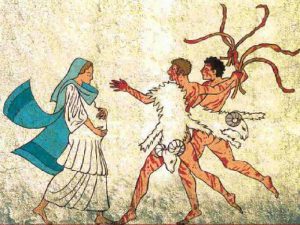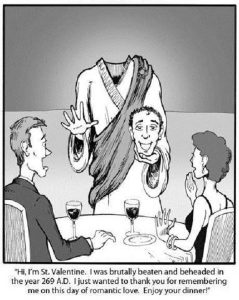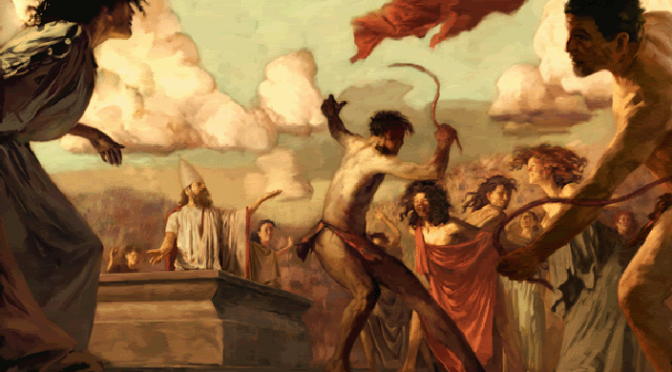As of this writing, we’re all of one day away from St. Valentine’s Day. A day of lovers, romance, and bitter singles – many wonder just how the day came to be associated with such warm or contemptuous feelings. Saints are generally chaste and unrelated to such things, so the idea of one being associated with young lovers is a bit hard to grasp. This is particularly true because the Catholic Church tells you to be ashamed of most emotions in one way or another and even defines a couple of them as cardinal sins. The only emotion the Church doesn’t seem to look down on at some point is guilt, which is probably why they so mercifully give you a shot of wine on Sundays. Of course, whenever such contradictions happen to come up it’s a good time to check for some sort of pagan holiday behind it all. Surprise, found one.

A quick google search for the origins of Valentine’s Day will no doubt produce dozens of articles talking about the Roman festival of Lupercalia, a fertility celebration held on February 15th. And this makes sense, the most common of Catholic celebrations started as a pagan tradition of some sort. Like Christmas, Halloween, and Easter, Valentines is said by many to be lifted from the traditions of the pagans. And, of course, you can’t spell Romance without Roman – the people who literally originated the “romance languages” and gave us the very words we need to express our deepest desires.

Just one problem: it would appear that the connection doesn’t really exist…
Confused By Chaucer

While many a blogger and website will cite Lupercalia as the origins of Valentine’s Day traditions, much of it is actually a modern reinterpretation of the day. Dedicated to Lupa, the wolf who was said to care for the Roman founders Romulus and Remus – the Lupercalia was actually a springtime festival dedicated to new beginnings and motherhood. Carried out by the Luperci, a well organized brotherhood dedicated to Faunus, the Lupercalia was a time of sacrificial rites used to try to usher in new life to the world. In the time of the Lupercalia two goats and a dog would be sacrificed to kick off the festivities and the Luperci, wearing nothing but goat skin, would go about the city of Rome striking women who wished to conceive – essentially blessing them to have a child.

If this is how you spend your Valentine’s… we need to talk.
Over time the celebration changed due to outside pressure by Christians as the church’s influence grew in the Roman capital. Though they did not outright ban it, they did heavily marginalize it over the centuries. The Luperci were once important figures, priests of Faunus who were also something akin to an exclusive fraternity. But as time went on it became less dignified to join in these festivities and it was soon left for only the lower classes while the upper class would do its best to either ignore the rites or demean anyone who would get involved.
Though it’s often cited that Pope Gelasius put an end to the rites once and for all and replaced it with something else, this actually doesn’t seem to have any basis in fact. Some stories claim that he established the day as the day of St. Valentine’s Feast, or replaced it with the Feast of the Purification of the Virgin Mary. However, neither of these have any proof and, of the two, the one with the most backing would be the Purification. Though Lupercalia was only observed within Rome, the rest of the empire actually celebrated Juno Februa, the purification of Juno, a similar but differently approached event. Were there actually a direct transfer from one holiday or feast to the next, the Purifications seem to be a better match. Regardless, it doesn’t seem to actually be based in any fact as Gelasius, though bitterly against the rites being carried out, was actually something of a smart-ass. Observing that people wanted to take part in the rites, Gelasius didn’t replace the festival but is instead said to have responded:
“If you assert that this rite has salutary force, celebrate it yourselves in the ancestral fashion; run nude yourselves that you may properly carry out the mockery.”
Or, to put it in a more modern parlance: “Sure, act a fool, but if you do it you better be naked.”

No, not only did Gelasius not put a firm end to the rites during his 4 years as Pope but they seemed to simply be shamed away without the rebranding so common in early Christianity. The reason for the confusion is fairly simple: though Gelasius did not actually establish a feast day for St. Valentine to compete with the Lupercalia on the 15th – he did establish one on the 14th. The reason for the proximity was actually fairly innocent in intent as the church assigns Saints to roughly every day of the year and Saint Valentine of Terni, one of the two Valentines most commonly recognized by the feast, actually died on February 14th – with St. Valentine of Rome being added in later to simplify the calendar. The event that Gelasius established was not only independent of the Lupercalia, it came with dramatically different connotations and was essentially the Vatican equivalent of “Tuesday”. In fact, no mention of romance or relationship related traditions on Valentine’s Day were mentioned for another 900 years when one lone poet said something that really screwed people up.

Geoffrey Chaucer, the poet famous for romanticizing the lives of knights, nobles, and court intrigue, decided to write a poem in 1382 dedicated to the first anniversary of the engagement of King Richard II and Anne of Bohemia. This poem stated that Valentine’s Day was the day of lovers, when every bride would seek their mate and tied Valentine’s Day into the idea of “lovebirds” as Chaucer wrote of even the birds being in love at the time. However, the poem starts to make no god damn sense due to two details. First, Richard and Anne were engaged in May – several months after February 14th. Second, the very idea of a bird mating season in the middle of February in England was asinine for some very obvious reasons.

Now some would say that, perhaps, Chaucer was simply reflecting the traditions of the time and connecting them to the important event. However, the fact of the matter is that no one else wrote about any of these “traditions” for 900 years and several poets all started writing about how birds were finding love around Valentine’s Day at roughly the same time. This would be mind boggling except for one fact: Chaucer was writing about a different Valentine.
While the more popular St. Valentines of Terni and Rome were always associated with February 14th a lesser known St. Valentine, an early bishop of Genoa, had a separate feast day in May. This feast day, happening closer to the actual mating season of birds, was even thought to have happened on the day of or immediately after the engagement of Richard to Anne. This engagement, being a power play to try to end the Hundred Years War, was a very hot topic at the time and made the festival a particularly notable one. As such, guys like Chaucer romanticized the hell out of the event and established St. Valentine as being associated with love.
As time went on, the lesser known Valentine of Genoa eventually got pushed out by other Saints who happened to come by. The number of people named “Valentine” to be martyred was surprisingly high and the idea of giving each of them a day was unfeasible at best and exhausting at worst. Rather, while the number of Saints built up, every Saint to have the name “Valentine” was eventually compressed down to the single day like a martyred Catholic guilt version of Captain Planet.

And the thing is, while Genoa was the one associated with romance, the attribute just passed over to the other Valentines over the years. With few people knowing who Valentine of Genoa was but knowing full well the big two associated with the day were, it was just easier to come up with stories about how romantic these bishops and priests were despite being, you know, tortured and executed by the Romans.

So when you or someone you know spends February 14th acting like a fool, don’t blame the Catholics, or the Pagans, or those bastards who sell you a flower for $10 a piece – blame Chaucer and his literal fucking birds. And when you remember those birds just keep in mind…
It could be a lot worse.
(I write novels. If I sound a little jaded, trust me, you have no idea. But if you want an idea, go ahead and check out my twitter.)







